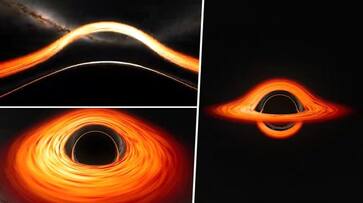Ever wondered how it feels to dive into a black hole? THIS video from NASA will amaze you (WATCH)
In the video, the viewers are immersed in the surreal experience of approaching a black hole from a distance of about 400 million miles. One scenario sees the viewer plunging past the event horizon, while the other shows a close orbit near the boundary, with a narrow escape to safety.

A recent video, released by NASA, offers a glimpse into the enigmatic realm of black holes, shedding light on what may happen if one were to venture too close. NASA posted the video on Monday (May 6) created by Jeremy Schnittman, an astrophysicist at NASA's Goddard Space Flight Center in Maryland, illustrating the captivating journey into the gravitational abyss.
"People often ask about this, and simulating these difficult-to-imagine processes helps me connect the mathematics of relativity to actual consequences in the real universe," Schnittman said, as reported by NASA. "So I simulated two different scenarios, one where a camera — a stand-in for a daring astronaut — just misses the event horizon and slingshots back out, and one where it crosses the boundary, sealing its fate."
In the video, the viewers are immersed in the surreal experience of approaching a black hole from a distance of about 400 million miles. One scenario sees the viewer plunging past the event horizon, while the other shows a close orbit near the boundary, with a narrow escape to safety.
Describing a black hole as a region "of such immense gravity that nothing -- not even light -- can escape from it," NASA highlighted the awe-inspiring magnitude of these cosmic phenomena. Schnittman collaborated with Goddard scientist Brian Powell in crafting these visuals, harnessing the computational power of the Discover supercomputer at the NASA Center for Climate Simulation.
"The destination is a supermassive black hole with 4.3 million times the mass of our Sun, equivalent to the monster located at the center of our Milky Way galaxy," the NASA said.
April 2024 warmest ever on record as temperature continues to soar globally: Report
Schnittman offered insights into the contrasting experiences of falling into supermassive black holes versus stellar-mass black holes, stressing the latter's stronger tidal forces and smaller event horizons, which pose significant dangers to approaching objects.
One peculiar phenomenon near a black hole is "spaghettification," where the gravitational forces cause stretching of objects, with stronger pull on the near end compared to the far end.
- Black hole
- biggest black hole
- black hole in space
- black hole milky way
- black hole nasa
- black hole star
- black hole sun
- black holes
- earth
- galaxy
- milky way
- nasa
- patagonia
- patagonia black hole
- space
- stars
- sun
- supermassive black hole
- the black hole
- universe
- what is a black hole
- what is black hole
- what is in a black hole
- what is the black hole
- white hole
- Goddard Space Flight Center

















